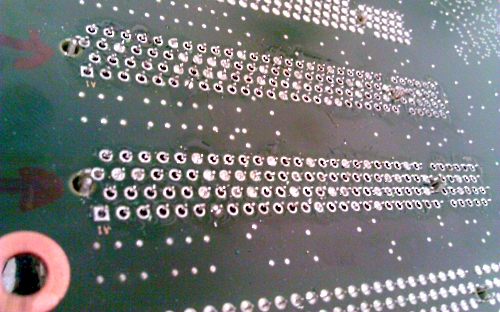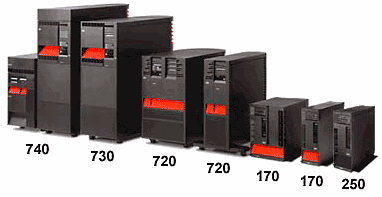IBM AS/400e
System Type: 9406 - 170
The AS/400 'e' lineup was released with an x86 Netfinity subsystem to also act as a webhost. However, with this unique addition to the nonstandard AS/400 platform, it allows the machine to also be able to do things most AS/400s can't (even the newer System i POWER machines: as they are exclusively running on POWER7 microprocessors and lack an x86 subsystem). The series in question on this page is the 170 series which seems to be the more widely available, or at least used to before the majority were no doubt recycled: most likely due to the fact that they take longer to load than newer AS/400s. It's worth noting that the Netfinity board seems to be optional and not all AS/400e machines were released with them by default.
Type 170 of the AS/400e series could be upgraded with a secondary compartment containing extra HDDs (and I think another processor board as well). This required a different type of bezel to be ordered from IBM to go across both compartments: as well as unscrewing the top lid in exchange for one that went across both etc. The design of the system consists of [many] screws so that virtually any section can be unscrewed. The above photo outlines the single tower, and the double-tower compartment option. It's worthy to note that the single tower system is 74 lbs-- the expanded system far exceeds 100 lbs and is not possible for a single person to carry.
A common 'cosmetic' malady of these computers is that the back bezel is often missing and the panel door is removed from the front bezel. Or even worse, the delicate PC-ABS plastic from either bezel is shattered on the corners from the heavy weight of the system in shipping.
Downloads
--> AS/400 Disk Storage Topics and Tools
--> Problem Analysis, Repair and Parts (AS/400e 170 and 250)
--> System Installation and Upgrade (AS/400e 170, 250, 6xx, 7xx)
These manuals have information pertaining to the AS/400e 170 series (as well as other ones mixed in). Especially useful for troubleshooting since all of your IPL codes are listed in there too-- along with FRUs.
OS/400
The 170s will run OS/400 with a theoretical cap of V5R3 (version 5, release 3). Older versions will operate faster than version 5: especially if you are still using the original [now vintage] DGHS double-height 3.5" SCSI drives that have originally been installed.
Obtaining of a copy of OS/400 (any version) is extremely difficult. It's something that rarely graces into the homes of an individual as these systems are meant to be running in businesses. If you're lucky, the vendor or IBM representative you buy the system from will be able to supply a copy of OS/400 if you need it.
I do NOT have the right to distribute this software, so please do not ask for it.
Hardware Nightmares
When I originally purchased my AS/400e 170, UPS didn't feel like lifting the 80+ lbs box and instead let it crash to the ground at least four feet or more. I didn't see this happen, but given all of the variables it's exactly what happened. This caused the front panel of the chassis to shatter, and hideously disfigured two of the PCI slots and corresponding cards. The machine itself was well packaged with injection foam and a giant stapled box, so excessive force had to be applied to damage components from internal shock.
The system boards for these systems are far less common and hard to find that I would like... so replacing the system board ['planar'] was never really an option: this is complicated by the manual which doesn't seem to call for the correct FRU for my system type 2889. Well it may indeed call for the correct FRU, but I have no way of verifying if any of them are for the system board itself, especially considering the system board has a different starting FRU.
The only option was to desolder the PCI slots, and replace them with new PCI slots. This required the use of a Hakko-808 and other gear, as some of the solder didn't heat up in the vias that well due to the board design and the many layers (it's a decently thick PCB). Here was what a standard Hakko-808 was able to remove (about 28% of the leads remaining):

In the process, this also damaged the PCI RAID card: so the system could not boot to the RAID to load OS/400. Of course plugging the SCSI to the onboard connector will just produce IPL code: 675A3250. Which in a generalized fashion means there's a disk issue causing the operating system not to be found. As such I had to inquire to my vendor if they would supply a copy of OS/400, which they agreed to.
Setting up a Terminal Session
To set up a real 'physical' terminal session, you'll need the following parts:
#1 A twinaxial controller card in the AS/400e (it should have one by default as it is a standard issue FRU for all systems)
#2 A quad twinaxial breakout box (connects to the controller card)
#3 An IBM 4236482 twinaxial cable to link the terminal and AS/400e
#4 A terminal capable of talking to the AS/400e, along with a terminal keyboard (typically a Model M or a Model F variant).
Note: my terminal of choice is an IBM 3489: to connect a twinax cable to it, you'll need the DB15 breakout cable which splits out to two twinax jacks-- allowing control of two sessions if necessary. It looks like IBM thought of making some with a single twinax port, as the original jack is shaped as such; some may have been made like that, I'm not sure. If there are some configured like that, the DB15 breakout won't be necessary.
Setting up Terminal Emulation
Terminal emulation can be done over the AS/400e's optional ethernet card-- however the OS must be installed first.

